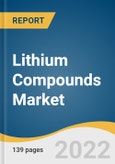The global lithium compounds market size is expected to reach USD 26.7 billion by 2030. It is expected to expand at a CAGR of 24.3% from 2022 to 2030. An increase in the electrification of vehicles is anticipated to drive the market.
Lithium mining is witnessing rapid growth as its demand is accelerating owing to its application in batteries. The element is found in dry places that require thousands of liters of water for mining. Considering the rising demand for elements and increasing usage of water for its extraction, R&D is in place to find better alternative methods.
Lithium carbonate is a salt of carbonate used widely in the processing of metal oxides. It is the first compound that is extracted from the brines and the first compound in the production chain. It is also a building block for other derivatives. Li-carbonate is used in various applications such as glass and ceramics, aluminum production, pharmaceuticals, and Li-ion batteries. It is also used to reduce the melting point of silica that is used in ovenware glass.
The batteries application segment dominated the market in 2021. Li-ion batteries have become the key factor for electric vehicles because they store more power per unit of weight compared to alternatives such as nickel-cadmium. Nickel-cadmium and nickel metal batteries were formerly used in computers and mobiles. However, due to their low power capabilities, shorter charge period, and heavy weight than Li-batteries, the demand for Li-ion batteries has increased as they have high energy density and are lighter in weight.
Lithium mining is witnessing rapid growth as its demand is accelerating owing to its application in batteries. The element is found in dry places that require thousands of liters of water for mining. Considering the rising demand for elements and increasing usage of water for its extraction, R&D is in place to find better alternative methods.
Lithium carbonate is a salt of carbonate used widely in the processing of metal oxides. It is the first compound that is extracted from the brines and the first compound in the production chain. It is also a building block for other derivatives. Li-carbonate is used in various applications such as glass and ceramics, aluminum production, pharmaceuticals, and Li-ion batteries. It is also used to reduce the melting point of silica that is used in ovenware glass.
The batteries application segment dominated the market in 2021. Li-ion batteries have become the key factor for electric vehicles because they store more power per unit of weight compared to alternatives such as nickel-cadmium. Nickel-cadmium and nickel metal batteries were formerly used in computers and mobiles. However, due to their low power capabilities, shorter charge period, and heavy weight than Li-batteries, the demand for Li-ion batteries has increased as they have high energy density and are lighter in weight.
Lithium Compounds Market Report Highlights
- Based on derivative, lithium chloride accounted for the second-largest market share in 2021. The demand is attributed to the increase in demand from the biomedical sector.
- The growing demand for Li-batteries in electronic devices and electric vehicles is driving the demand for Li-compound globally.
- Lithium metal is anticipated to drive the demand for chloride as it is used as a feed material.
- by application, the glass and ceramics segment emerged as the second-largest segment in terms of value in 2021 as there is an increase in demand for consumer goods, thus driving the demand for Li-compound.
- The ceramics industry makes use of Li-carbonate to render color and shine, which, in turn, is expected to drive the demand for Li-compound.
Table of Contents
Chapter 1 Methodology & Scope
Chapter 2 Executive Summary
Chapter 3 Lithium Compounds Market: Market Variables & Trends Analysis
Chapter 4 Lithium Compounds Market: Derivative Estimates & Trend Analysis
Chapter 5 Lithium Compounds Market: Application Estimates & Trend Analysis
Chapter 6 Lithium Compounds Market: Regional Estimates & Trend Analysis
Chapter 7 Competitive Analysis
Chapter 8 Company Profiles
Companies Mentioned
- Albemarle Corporation
- Sqm S.A.
- Livent Corporation
- Tianqi Lithium Corporation
- Lithium Americas Corp.
- Orocobre Limited
Methodology

LOADING...
Table Information
| Report Attribute | Details |
|---|---|
| No. of Pages | 139 |
| Published | April 2022 |
| Forecast Period | 2022 - 2030 |
| Estimated Market Value ( USD | $ 3.8 Billion |
| Forecasted Market Value ( USD | $ 26.7 Billion |
| Compound Annual Growth Rate | 24.3% |
| Regions Covered | Global |
| No. of Companies Mentioned | 6 |









